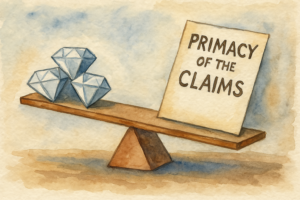G 1/24 addresses the extent to which the description can be used to interpret the claims. As previously discussed, it looks set to be one of the most consequential EPO decisions of the decade. The hearing in G 1/24 took place on 28 March, with the opponent advocating a new “diamond standard” that the “description and drawings should be used to interpret the claims“, while patentee favoured the primacy of the claims approach. In case you missed it, here is a brief (and non-exhaustive) summary of some of the main points raised.

Questions
The following questions were referred:
1. Is Article 69 (1), second sentence EPC and Article 1 of the Protocol on the Interpretation of Article 69 EPC to be applied to the interpretation of patent claims when assessing the patentability of an invention under Articles 52 to 57 EPC?
2.May the description and figures be consulted when interpreting the claims to assess patentability and, if so, may this be done generally or only if the person skilled in the art finds a claim to be unclear or ambiguous when read in isolation?
3. May a definition or similar information on a term used in the claims which is explicitly given in the description be disregarded when interpreting the claims to assess patentability and, if so, under what conditions?
Admissibility of the questions
The preliminary opinion of the Enlarged Board tended to find questions 1 and 2 admissible, placing the ball in patentee’s court. Their main argument was that this issue has already been decided by the Enlarged Board. Reference was made in particular to G 2/12:
A distinction needs to be made between, on the one hand, the aspects of patentability and, on the other hand, the (protective) effects of European patents or patent applications. The EPC clearly provides for such a clear division, as the requirements for patentability are governed by Articles 52 to 57, 76, 83, 84 and 123 EPC whereas the extent of protection and the rights conferred by European patents or patent applications are specified in Articles 64(2) and 69 EPC in particular… As a consequence, whether a product claim or a product-by-process claim is patentable is to be examined irrespective of the extent of protection that is conferred by it after grant.
While certainly relevant to the present case, we’re not convinced that specifically the issue of claim interpretation has been decided. Add to this the fact that an earlier decision of the Enlarged Board does not preclude a later (even contradictory) one, and it seems likely that the preliminary opinion on this point will be maintained.
As for the third question, the preliminary opinion of the Enlarged Board tended to find this inadmissible. This wasn’t heavily challenged by the opponent or the EPO President. Perhaps because, as the EPO President put it, this third question is a subset of the second. Regardless of whether the decision explicitly addresses this point, we hope that it provides a clear basis to determine whether definitions of claim terms can be disregarded.
Questions 1 and 2
As question 3 looks less likely to be relevant, in the following we will focus on the discussion on questions 1 and 2. The Enlarged Board’s preliminary opinion doesn’t come to a clear conclusion for question 1. However, they generally “recognise the interest in uniform application of the principles of claim interpretation both in patent grant proceedings… and also in post grant revocation and infringement proceedings“. And for question 2 they preliminarily concluded that “the description and the figures can be referred to in the course of claim interpretation“. This places the burden on patentee to explain why Article 69, which undoubtedly deals with claim interpretation for infringement, should not be relied on.
Patentee
Paraphrasing George Orwell, patentee responded that “[all parts of the application are equal, but] some parts of the application are more equal than others“.

Picture of George Orwell which appears in an old accreditation for the BNUJ.
Namely, the patent is an “asymmetric legal document“, in which the claims have primacy. Legal basis for this is to be found in the first line of Article 84 EPC “The claims shall define the matter for which protection is sought“. Leading decisions such as T 56/21 discussed here were cited in support of these arguments.
As for using Article 69 EPC, patentee warned of Donald Rumsfeld’s “unknown unknowns” following any change to EPO practice on claim interpretation, decreasing legal certainty. Article 2 of the protocol raises the spectre of equivalents being brought into claim interpretation along with Article 69, which would undermine the famous EPO gold standard. While this is an unappealing prospect, it may not be enough to dissuade the Enlarged Board from at least adopting the principles of Article 69 EPC for claim interpretation.
It was also interesting that patentee accepted that the description can be used to interpret the claims, if the claims are unclear. This is based on a well-established line of EPO case law, and is consistent with their position in the opposition case. But it does raise the question of where exactly this principle can be found in the Convention, especially if Article 69 EPC is not relevant. In our view the second sentence of Article 84 EPC doesn’t read very easily onto this scenario.
Opponent
Opponent meanwhile advocated a new “diamond standard” that the “description and drawings should be used to interpret the claims“, to complement the existing gold standard. Legal basis for this can be found in Article 69 EPC, it being the only article to expressly address claim interpretation. They argued that this is critical to avoid the “angora cat” problem: where patentee adopts a broad claim interpretation for infringement but a narrow one for validity. It was also pointed out that Articles 100 and 138 EPC require the assessment of “the subject matter of the European patent”, a broader concept already encompassing the description. If this did not provide appropriate basis, Article 125 EPC would kick in, meaning that the same principles would be adopted anyway in view of the principles applied in the contracting states.
This last point is somewhat controversial, as Article 125 EPC is restricted to procedural law, while interpretation is arguably substantive. Otherwise, as discussed here, their fundamental point seems sound, that the same approach should be taken for both validity and extent of protection in all European forums.
EPO President
The EPO president referred to Article 1 EPC and the goal of creating a “system of law, common to the contracting states“, and argued for the same interpretation pre-and post grant. In their view, multiple sources in the EPC including Articles 84 and 69 EPC suggest that the claims should be interpreted based on the description. The description has a secondary role, but a role nonetheless.
Interestingly, they also made a plea that the issue of adaptation of the description also be settled in G 1/24. It will be interesting to see if the Enlarged Board takes this up. A decision on this would certainly be welcome. If not, it looks likely that another referral on this issue will be made in T 697/22 later this year.
Enlarged Board
Meanwhile, the Enlarged Board did not give much away. The only question came from legal member D. Rogers, who asked whether Article 1 of the protocol goes beyond Article 69 EPC first sentence. The relationship between these elements of the EPC might be relevant for the decision, and in particular whether reasoning based on Article 69 also requires the protocol.
The Chairman concluded the oral proceedings stating that their “real work” now begins, suggesting that there is much for them still to form an opinion on. That said, although the pleading from all parties was of a high standard, it seemed that no significant new points emerged in the hearing.
At this stage then, it seems likely that the preliminary opinion will be maintained, i.e. that at least the principles of Article 69 EPC can be applied, such that the description and figures can be referred to.
________________________
To make sure you do not miss out on regular updates from the Kluwer Patent Blog, please subscribe here.


